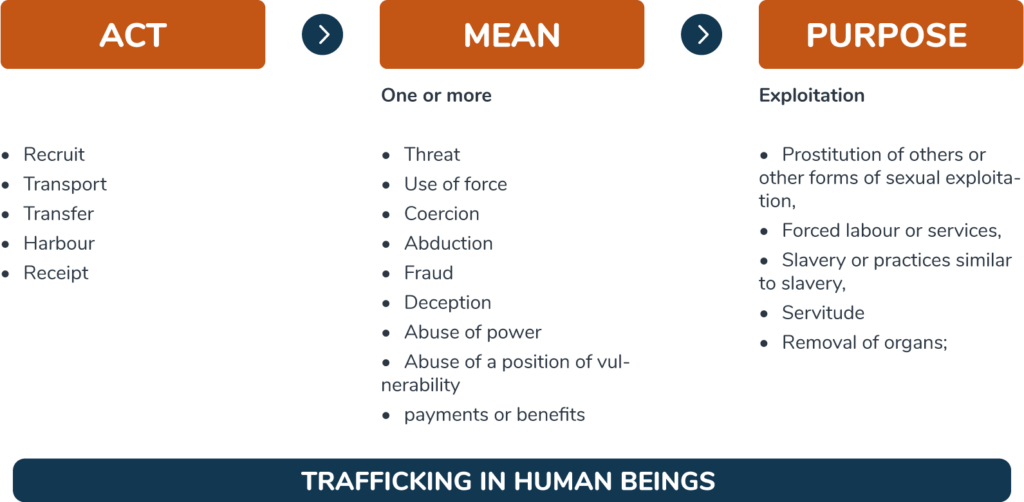Definition of human trafficking
Trafficking in human beings is a serious crime and a violation of human rights
According to article 4 of the Council of Europe Convention on Action against Trafficking in Human Beings and article 3(a) of the Protocol to Prevent, Suppress and Punish Trafficking in Persons, Especially Women and Children, supplementing the United Nations Convention against Transnational Organized Crime (the so-called Palermo Protocol), trafficking in human beings shall mean :
the recruitment, transportation, transfer, harbouring or receipt of persons, by means of the threat or use of force or other forms of coercion, of abduction, of fraud, of deception, of the abuse of power or of a position of vulnerability or of the giving or receiving of payments or benefits to achieve the consent of a person having control over another person, for the purpose of exploitation. Exploitation shall include, at a minimum, the exploitation of the prostitution of others or other forms of sexual exploitation, forced labour or services, slavery or practices similar to slavery, servitude or the removal of organs;

Elements of trafficking

The definition of victim
The Council of Europe Convention on Action against Trafficking in Human Beings defines the concept of “victim”, while other international instruments leave it to each State to determine who is a victim who is the beneficiary of protection and assistance measures.
According to Article 4 (e) of the Convention, any natural person who is subjected to trafficking in human beings must be considered a victim, even if the exploitation has not commenced.
The concept of victim consent
Article 4(b) of the Council of Europe Convention on Action against Trafficking in Human Beings provides that the consent of a victim of trafficking in persons is irrelevant when one of the means [the threat or use of force or other forms of coercion, of abduction, of fraud, of deception, of the abuse of power or of a position of vulnerability or of the giving or receiving of payments or benefits] has been used.
In other words, if the victim has consented to his/ her exploitation because one of the above-mentioned means has been used, the Convention considers that he/she has not really consented.
Example: Sarah consented to sexual exploitation because her operator threatened to harm her daughter if Sarah did not comply. Sarah is not really consenting.
The case of child trafficking
The term “children” refers to minors under the age of 18. In the case of the exploitation of a minor, it is not necessary to prove the use of means for the crime of trafficking in human beings to be legally qualified. This implies that children’s consent to trafficking is irrelevant.
Example: Samuel, 16 years old, is exploited in a family as part of domestic servitude. To prove that he is a victim of trafficking, it is not necessary to prove that he has been threatened, deceived, abducted etc. Nor is it necessary to prove that he did not fully consent.
National and international trafficking
The Palermo Protocol applies only to certain offences of a transnational nature and involves an organised criminal group.
The Council of Europe Convention has a broader scope of application than the Palermo Protocol, as it applies to national and transnational trafficking, whether or not related to organised crime.
The difference between human trafficking and migrant smuggling:
There is some confusion between the crime of trafficking in human beings (THB) and migrant smuggling. However, they are two separate crimes.
The smuggling of migrants is primarily a crime against the migration laws of a State, while trafficking in human beings constitutes a crime against an individual and a violation of human rights. In the case of smuggling of migrants, the person is generally consenting or even initiating his trafficking.
Secondly, the smuggling of migrants requires a transnational dimension that is not required in the constituent elements of the crime of trafficking in human beings. The use of coercion is also not necessary to establish. As for the act, it results in illegal entry into a country and the purpose of this crime is not the subjection of people to exploitation but to have a financial or material gain.
However, this does not prevent migrants from becoming victims of human trafficking.
Here is a comparative table explaining the differences between human trafficking and migrant smuggling:
| Trafficking in human beings | Migrant smuggling |
| Transnational or internal | Necessarily transnational |
| Act: Recruitment, transportation, transfer, harbouring or receipt | Act: Illegal entry |
| Objective: to exploit the victim | Objective: to derive a financial or material advantage by ensuring the illegal crossing of a border of a non-national or non-permanent resident of that State. |
| Consent : irrelevant if recourse to a mean | Consent: the person agrees to use the services of the trafficker or is at the initiative of his trafficking unless there is a hidden purpose of exploitation. |
| Relationship between the trafficker and victim: continues after displacement | Relationship between trafficker and victim: endsafter crossing the border. Unless there is a hidden purpose of exploitation, it becomes human trafficking. |
| The victim is the individual | The victim is the state |

